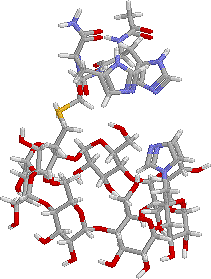Research
 My research
group is pursuing studies in several different areas. In our major effort we
are trying to prepare artificial enzymes that can imitate the function of
natural enzymes. Students typically design a potential catalyst on the
computer, synthesize it, then determine its catalytic effectiveness and the
mechanism involved. One of the most interesting recent successes is the
preparation of such enzyme mimics that carry out selective oxidations of bound
substrates with geometric control of the position attacked. In this way we
override the natural reactivities of the substrate by using the geometric
control imposed by defined binding to the catalyst.
My research
group is pursuing studies in several different areas. In our major effort we
are trying to prepare artificial enzymes that can imitate the function of
natural enzymes. Students typically design a potential catalyst on the
computer, synthesize it, then determine its catalytic effectiveness and the
mechanism involved. One of the most interesting recent successes is the
preparation of such enzyme mimics that carry out selective oxidations of bound
substrates with geometric control of the position attacked. In this way we
override the natural reactivities of the substrate by using the geometric
control imposed by defined binding to the catalyst.
A related study involves the synthesis of mimics
of antibodies or of biological receptor sites, constructing molecules that will
bind to polypeptides with sequence selectivity in water, using mainly
hydrophobic interactions. These could be very useful in modulating the activity
of peptide hormones, for instance.
Reactions in water can be influenced by the
hydrophobic effect. We are studying the use of this effect to promote and
direct chemical reactions, and also to furnish information about the geometries
of transition states. The results have been striking, furnishing information
not available by other techniques.
We have had a long-standing program to develop
novel compounds that can induce cells to differentiate. These have important
potential in cancer treatment, and are now in human trials. One of these
compounds has now been approved by the U. S. Food and Drug Agency for use by
cancer patients.
In our earliest work we extended the range of
aromatic compounds, and synthesized other compounds that we showed to be
antiaromatic. We are still pursuing studies on antiaromatic compounds,
particularly those with triplet ground states that have potential applications
in materials science.